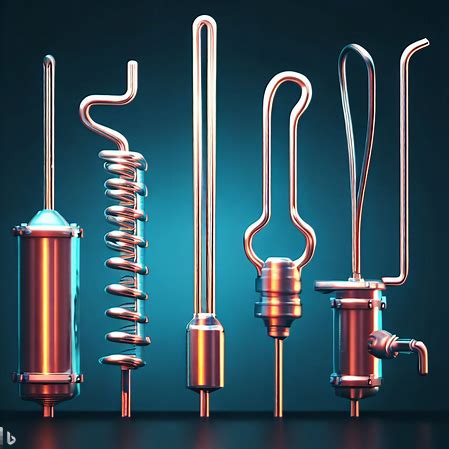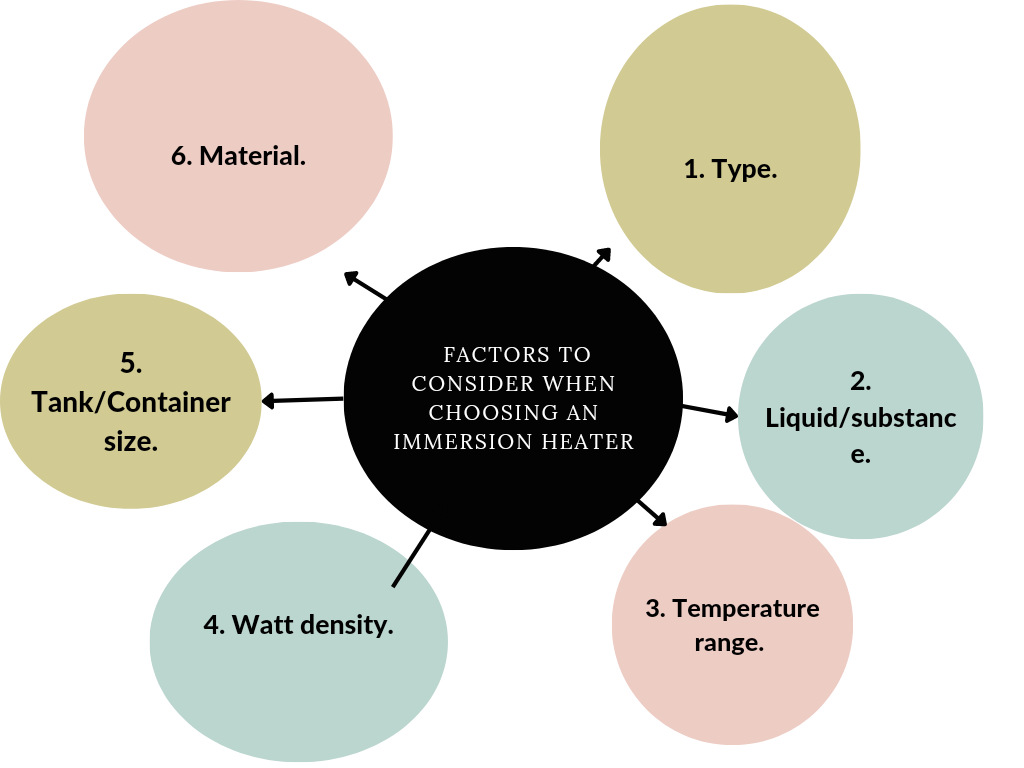Table of Contents
Immersion heaters are a popular choice for heating liquids in various industries. They’re versatile devices, able to heat both small and large volumes of liquid, perfect for a variety of applications.
Let’s explore the different types of immersion heaters available and their unique features.
The screw plug immersion heater is designed to be inserted into a tank or container through a threaded connection. Easy to install and use – what more could you want?
Flange immersion heaters, on the other hand, secure to the tank wall using a matching flange for an even heat distribution.
Material used for these heaters depends on the application and medium being heated. Stainless steel is common for its durability and corrosion resistance. Titanium is great for corrosive liquids. Tubular elements are often the heating element of choice due to their high watt densities and efficient heat transfer.
Immersion heaters find applications in residential properties, too. Use them to heat water in tanks, or provide freeze protection during cold weather. Low watt density versions work well for heating oils and viscous materials.
But remember, immersion heaters can get extremely hot. Use caution when operating them. When properly installed and maintained, though, they’re generally safe and efficient.
What are Immersion Heaters?

Immersion heaters are heating devices that are submerged in liquids or mediums to heat them up. Different types are available, each catering to different heating applications and conditions. They’re used in industries such as food processing, chemical, and oil, as well as for residential purposes.
These heaters come in different wattages and power densities to suit various temperature ranges and fluid types. They can be made from materials like stainless steel, titanium, or quartz. Some have sheath materials specifically designed for heavy-duty or corrosive environments.
Using immersion heaters is relatively safe if precautions are taken. Follow installation guidelines and ensure adequate temperature control to prevent overheating or damage. Regular maintenance and inspection should also be carried out to identify any issues early on.
Discover the benefits of immersion heaters today! Upgrade your heating system now for improved performance and efficiency. From screw plug to flange heaters, find the perfect solution for your heating needs. And don’t forget to add my collection of dark humor jokes to your own!
Different Types of Immersion Heaters

Immersion heaters come in various shapes and sizes, tailored for different heating applications. Let’s dive into the different types and their unique features!
Side Immersion Heaters: Installed on the side of a tank. They evenly distribute heat across the liquid or medium being heated. Commonly used in industrial and commercial settings.
Plug Heaters: Mounted through an opening in the tank wall. Provide direct heat transfer. Great for freeze protection and heating viscous materials, such as in food processing and chemical manufacturing.
Flange Heaters: Equipped with a matching flange. Ensure efficient heat transfer by close contact between the heating element and the medium being heated. Commonly used in oil storage tanks and water treatment facilities.
Specialized immersion heaters are made for specific industries and applications, too. For instance, tubular elements made of stainless steel or titanium can be used to heat corrosive liquids. Quartz immersion heaters are great for precise temperature control, like in labs.
A story about the importance of choosing the right type of immersion heater:
My friend works in a chemical industry. They were using a standard plug heater, instead of an indirect immersion heater suitable for their heavy-duty chemical processes. This caused excessive wear and tear, frequent replacements, and high operating costs.
They eventually switched to an indirect immersion heater, designed for heating corrosive chemicals at high temperatures. Maintenance issues decreased, energy efficiency improved, and downtime was reduced.
Immersion heaters have immense potential – more than a politician trying to win votes!
Applications and Uses of Immersion Heaters
Immersion heaters are heating devices with many uses. They heat liquids or materials by submerging them in the substance. Commonly used to heat water, oils, chemicals and other viscous materials in tanks, containers and vessels.
Here’s some applications for immersion heaters:
| Industry/Setting | Application/Use |
| Food Processing | Heat liquids for cooking or keeping temps in food production. |
| Brewing | Control temps during beer fermentation and processing. |
| Chemical Industry | Heat chemicals in containers to get desired reaction temps. |
| Nuclear Power Plants | Used for process heat, freeze protection, and temp control. |
| Air and Water Treatment | Mainly used for heating solutions, air purification and boilers. |
In summary, immersion heating has revolutionized many industries. It’s an efficient and reliable means of heating. Finding the right immersion heater is key – you want efficiency, heat distribution and no risk of burning!
Factors to Consider When Choosing an Immersion Heater

When picking an immersion heater, there are many factors to consider. You must consider the kind of liquid or substance you need to heat, as well as the desired temperature range and watt density. It’s also important to figure out the size and material of the container or tank, and determine if a screw plug, flange, or side immersion heater is best.
To give an informative overview, here’s a table with the key factors to consider when selecting an immersion heater:
| Factors | Description |
|---|---|
| Type | Choose from screw plug, flange, and side immersion heaters |
| Liquid/Substance | Consider the material being heated |
| Temperature Range | Determine the desired temperature range |
| Watt Density | Measure the amount of heat needed per unit area |
| Tank/Container Size | Ensure the heater fits properly |
| Material | Pick a heater with a compatible sheath material |
Plus, there are other unique features to think about. For example, some immersion heaters are made for heavy-duty industrial applications such as food processing and chemical industries. These heaters must be capable of handling viscous materials or being resistant to corrosive substances.
To make the best selection of an immersion heater, it is essential to take all details into account. Different types of heaters have their own advantages and uses. By considering wattage, sheath material, temperature control mechanisms, and installation requirements, you can guarantee optimal performance and energy efficiency.
Don’t miss out on the perfect immersion heater for your needs. Look at the factors mentioned above before deciding. Heat transfer methods differ depending on the kind of heater used in industry products. Make sure you pick the right one for your specific requirements, so you can enjoy reliable and efficient heating solutions. Who needs a life jacket when you have two immersion heaters?
Common Questions and Concerns about Immersion Heaters
Immersion heaters are widely used for heating liquids in many industries. Let’s explore some common queries about them. Here is a summary of the key info:
| Common Questions and Concerns about Immersion Heaters | |
|---|---|
| Question | Answer |
| Are immersion heaters safe to use? | Yes, when used properly and with necessary precautions. |
| Are immersion heaters expensive to run? | The energy costs associated with operating immersion heaters can vary. However, efficient models can help reduce costs. |
| What are the different types of immersion heaters? | There are several types of immersion heaters available including side immersion heaters. These are designed to be mounted on the side of the tank or container. |
One noteworthy point is that other types may be installed directly into the liquid or through a flange fitting on the tank wall.
Pro Tip: When selecting an immersion heater, take into account wattage, sheath material, and temperature control options to achieve optimal performance and efficiency.
In conclusion, understanding the different types of immersion heaters and their applications can help you pick the most suitable one for your needs. I may not be an immersion heater, but I sure know how to keep things heated!
Conclusion
Immersion heaters are an ideal choice for liquid heating and temperature control. Many types are available, each with its own design and features suited to certain needs. High power density, even heat distribution, and resistance to corrosive substances? There’s a heater for that!
Heaters are popular in food processing, chemical, oil, and nuclear power industries. Choose from screw plug, flange, side, or indirect varieties. Consider wattage, temperature control, and sheath material when selecting the right one.
Screw plug heaters are easy to install. They consist of an element in a screw plug. Flange heaters have a matching flange for direct contact with the medium. Side heaters mount vertically on a container side. Indirect heaters heat without direct contact.
Pro Tip: Select the right heater for optimal efficiency and long-term performance.
